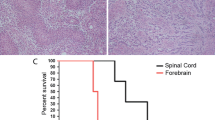Abstract
Introduction into fetal rat brain cells of a replication-defective retroviral vector harboring v-Ha-ras and v-gag-myc rapidly causes the induction of highly malignant undifferentiated neuroectodermal tumors following transplantation into the brains of syngeneic hosts [Wiestler, et al. (1992) Cancer Res. 52: 3760–3767]. In the present study, we have investigated the modulating effect of the developmental stage of neural target cells and of the dose of the retroviral vector used in the grafting experiments. Exposure of fetal cells from embryonic day (E)12 or E14 produced a 100% incidence of malignant neuroectodermal tumors which led to the death of recipient animals after a median latency period of 32 days. A 100-fold reduction of the virus dose from 2.062×106 to 2.062×104 focus-forming units/ml resulted in a lower tumor incidence of 25%. Of six neural grafts exposed to v-Ha-ras and v-myc at E16, only one showed evidence of tumorigenesis (low-grade astrocytoma and hemangioma). All other transplants were morphologically normal for observation periods of 26 weeks, indicating a marked loss of transforming activity of ras and myc in more advanced stages of brain development. In retrovirus-exposed donor cells which caused the development of neural tumors in recipient rats, malignant transformation was also evident during culture in vitro, usually after 9–12 days. Oncogene complementation was also studied in the newborn rat brain. After microinjection of the retroviral vector into the brain at postnatal day (P)0, P1 and P3, 5 out of 20 animals (25%) developed a total of seven brain tumors. Histopathologically, three of these neoplasms were malignant neuroectodermal tumors which, in contrast to those induced in fetal brain transplants showed evidence of focal glial and/or neuronal differentiation. In addition, we observed one oligodendroglioma, two hemangiomas and a malignant hemangioendothelioma. These data indicate that neural precursor cells and endothelia of the rat brain represent the major target cells for the complementary action of ras and myc and that the use of target cells from later developmental stages (E16 and postnatal) leads to the induction of both primitive and more differentiated neoplasms.
Similar content being viewed by others
References
Aguzzi A, Kleihues P, Heckl K, Wiestler OD (1991) Cell type-specific tumor induction in neural transplants by retrovirus-mediated oncogene transfer. Oncogene 6:113–118
Brüstle O, Petersen I, Radner H, Höll Th, Plate K, Kleihues P, Wiestler OD (1993) Complementary tumor induction in neural grafts exposed to N-ethyl-N-nitrosourea and an activated myc gene. Carcinogenesis (in press)
Burger PC, Shibata T, Aguzzi A, Kleihues P (1988) Selective induction by N-nitrosoethylurea of oligodendrogliomas in fetal forebrain transplants. Cancer Res 48:2871–2875
Cepko C (1989) Lineage analysis and immortalization of neural cells via retrovirus vectors. In: Boulton AA, Baker GB, Campagnoni AT (eds) Neuromethods, vol 16. Molecular neurobiological techniques. Humana Press, Clifton, pp 177–219
Cepko CL, Roberts BE, Mulligan RC (1984) Construction and applications of a highly transmissible murine retrovirus shuttle vector. Cell 37:1053–1062
Compere SJ, Baldacci P, Sharpe AH, Thompson T, Land H, Jänisch R (1989) The ras and myc oncogenes cooperate in tumor induction in many tissues when introduced into midgestation mouse embryos by retroviral vectors. Proc Natl Acad Sci USA 81:2224–2228
Cone RD, Mulligan RC (1987) High efficiency gene transfer into mammalian cells: generation of helper-free recombinant retrovirus with broad mammalian host range. Proc Natl Acad Sci USA 81:6349–6353
Farber E, Cameron R (1980) The sequential analysis of cancer development. Adv Cancer Res 31:125–226
Foulds L (1958) The natural history of cancer. J Chronic Dis 8:2–37
Hecker E, Fusenig NE, Kunz W, Marks F, Thielmann HW (1982) Carcinogenesis: a comprehensive survey, vol 7. Raven Press, New York
Kleihues P, Radner H, Aguzzi A, Wiestler OD (1991) Cell-specific tumor induction in neural grafts by retrovirus-mediated oncogene transfer. In: Ikuta F (ed) Neuropathology in brain research, International Congress Series 962. Excerpta Medica, Elsevier Science Publishers, Amsterdam, pp 201–209
Kleihues P, Burger PC, Scheithauer BW (1993) Histological typing of tumours of the central nervous system (WHO). Springer-Verlag, Berlin Heidelberg New York Tokyo (in press)
Marion MJ, Froment O, Trepo C (1991) Activation of Ki-ras gene by point mutation in human liver angiosarcoma associated with vinyl chloride exposure. Mol Carcinog 4:450–454
Nowell P (1976) The clonal evolution of tumor cell populations. Science 194:23–28
Peto R (1977) Epidemiology, multistage models, and short term mutagenesis tests. In: Origins of human cancer. Cold Spring Harbor Laboratory, Cold Spring Harbor, NY, pp 1403–1428
Thompson TC, Southgate J, Kitchener G, Land H (1989) Multistage carcinogenesis induced by ras and myc oncogenes in a reconstituted organ. Cell 56:917–930
Wiestler OD, Aguzzi A, Brüstle O, Eibl RH, Radner H, Kleihues P (1991) Oncogene complementation in transgenic neural transplants. Proceedings of the XIth International Congress of Neuropathology Kyoto, September 2–8, 1990. Neuropathology [Suppl], pp 304–309
Wiestler OD, Brüstle O, Eibl RH, Radner H, Aguzzi A, Kleihues P (1992) Retrovirus-mediated oncogene transfer into neural transplants. Brain Pathol 2:47–59
Wiestler OD, Brüstle O, Eibl RH, Radner H, von Deimling A, Plate K, Aguzzi A, Kleihues P (1992) A new approach to study the molecular basis of neoplastic transformation in the brain. Neuropathol Appl Neurol 18:443–453
Wiestler OD, Aguzzi A, Schneemann M, Eibl RH, von Deimling A, Kleihues P (1992) Oncogene complemementation in fetal brain transplants. Cancer Res 52:3760–3767
Author information
Authors and Affiliations
Additional information
These studies were supported by the Fonds zur Förderung der wissenschaftlichen Forschung in Österreich (Erwin Schrödinger fellowship, JO501-MED), by the Swiss National Science Foundation and by the Cancer League of the Kanton of Zürich
Rights and permissions
About this article
Cite this article
Radner, H., El-Shabrawi, Y., Eibl, R.H. et al. Tumor induction by ras and myc oncogenes in fetal and neonatal brain: modulating effects of developmental stage and retroviral dose. Acta Neuropathol 86, 456–465 (1993). https://doi.org/10.1007/BF00228580
Received:
Revised:
Accepted:
Issue Date:
DOI: https://doi.org/10.1007/BF00228580




